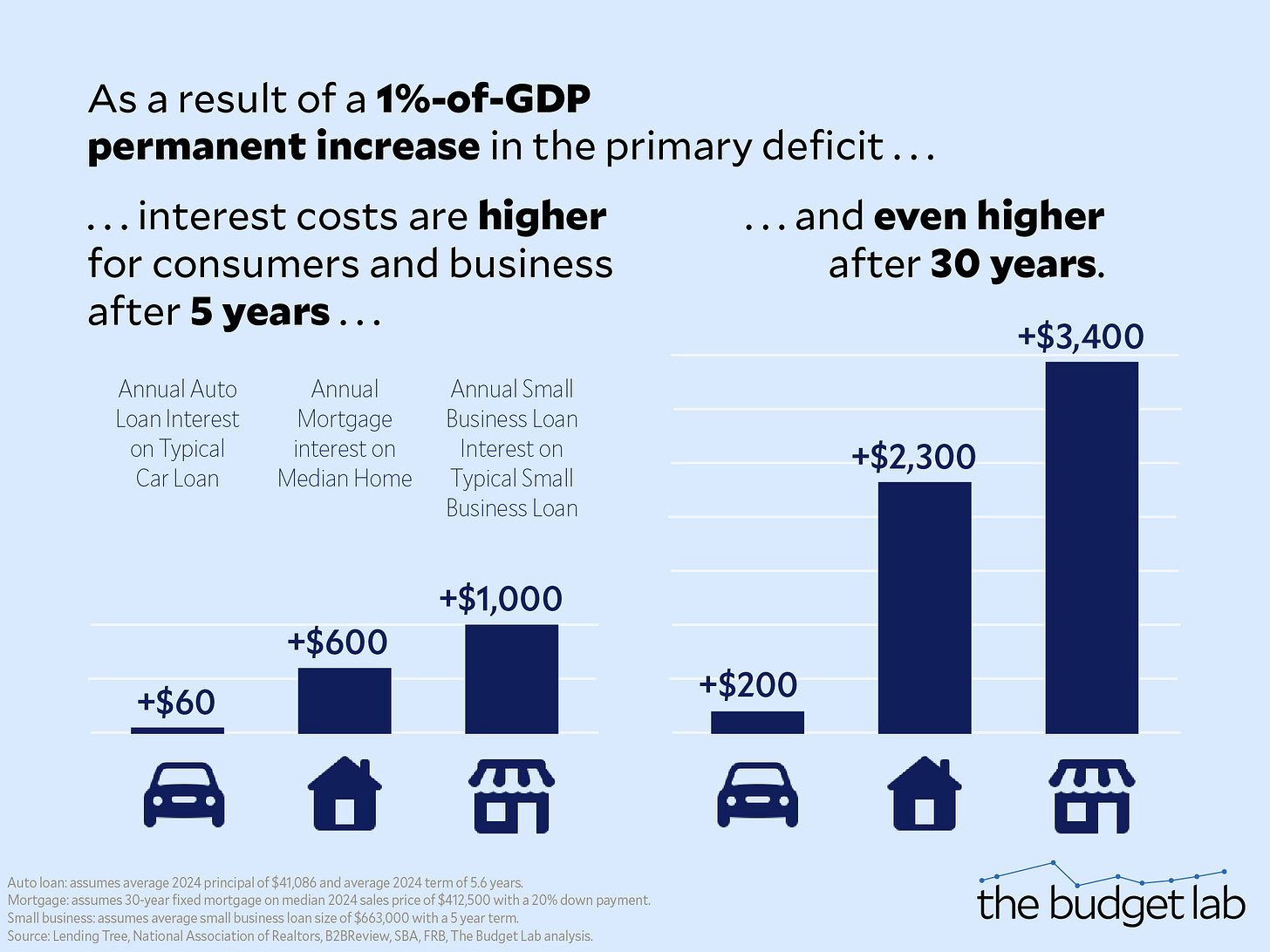I have written about the main spending cut (a stealth cut in Medicaid Benefits) in the “Big Beautiful Bill” that is moving through Congress, but the tax features in the Bill also deserve attention. My bottom-line: The tax parts of the bill make no sense from economically and will drive our already historically high deficit and debt levels even higher.
The bill includes $3.8 trillion in tax cuts. Most of this comes from locking in the previous 2017 Trump personal income tax cuts (which largely favored the wealthy through lower marginal rates and a higher threshold for estate taxation), but it also includes some Trump campaign promises to eliminate taxes on tips, overtime, and car loans. Due to pressure from New York and California congressmen, it also increases the limitation of deduction of state and local taxes (how much higher is still under debate). Business tax cuts include allowing expensing of R&D investments and a new tax break to build factories.
The bill, however, isn’t just about tax cuts. It also includes significant tax increases focused on institutions and groups that the Republican majority disfavors. University endowments (which largely fund financial aid) will see a massive increase from 1.4 percent to as high as 21%. Lawful immigrants to the U.S. who do not have green cards would no longer be able to receive tax credits for health insurance premiums—which would affect H-1 visa holders, asylees and refugees, and those on student visas. It would also limit the time allowed to take advantage of the clean energy tax credits in the Inflation Reduction Act. With limited exceptions, the tax credit on electric cars would phase out by the end of the year.
So what’s the problem?
First, even with the large cuts in Medicaid and SNAP (food stamps), the net effect of the bill is to make our budget deficit even worse. The Center for American Progress has done a useful analysis. The $3.8 trillion (over 10 years) revenue loss from the tax provisions in the bill is offset by $1.1 trillion spending cuts. (The cuts to Medicaid and SNAP actually amount to $1.5 trillion, but there is an offsetting increase to the Defense and Homeland Security budgets). So the bottom-line is that the budget deficit will grow be $2.7 trillion, and that is before the increased interests costs are taken into account. The increased interest cost will be $579 billion. And the Republicans used a favorite (and bipartisan) budget gimmick to hide the real cost of the tax package—they added a phase-out to some of the tax cuts with the understanding that the cuts will likely be made permanent at some point. If these cuts are made permanent, there will be a $4.5 trillion increase in the deficit, plus $755 billion in increased interest costs.
The net result of all of this on our national debt? CAP gives the grim news:
Federal debt would rise to a hefty 125 percent of GDP by 2034. By 2055, the legislation would cause federal debt to rise to 178 percent of GDP, a mammoth level. In contrast, absent these changes, the federal debt would reach 156 percent of GDP in 2055 under current law. The legislation’s increased debt would sap wage growth enough over time to leave Americans on average poorer than they otherwise would be.
While Republicans deficit hawks are blocking the bill as a result, they want more cuts to Medicaid rather than reduced tax cuts. And moderates are advocating for an extremely expensive increase in the deduction for state and local taxes that could drive the deficit numbers even higher. Who will win this battle? Hard to say, but my moneys on the hawks. Moderate Republicans almost always cave.
So why should average Americans care about the increase in our national debt? I had an earlier post about how we have a serious and significant structural deficit that neither party seems willing to address. This bill will make the problem even harder to address. And an increase in the deficit has real consequences for American consumers and businesses. The Yale Budget Lab estimates that the result of a 1%-of-GDP increase in the deficit means increased costs for car loan, mortgages and business loans:
The conventional economic models we use show that in the short-run, a permanent primary deficit increase of 1% of GDP—roughly in line with the cost of fully extending the individual provisions of the Tax Cuts and Jobs Act—raises inflationary pressure after 5 years equivalent to a loss in household purchasing power of $300-1,250 per household in 2024$. (This is a subset of the total economic effect of higher debt.) A more unconventional model raises the possibility that the effect is even higher in the short-run. This effect alone is more than half the benefit of the policy itself.
Second, while conventional economic theories says that only tax cuts that affect marginal rates have the potential to increase economic growth, many of the tax cuts simply reduce the tax base for one favored group over another. This is true of elimination of taxes on tips, overtime and car loans. The car loan example may be the most egregious. As Gordon Ip explained in the Wall Street Journal:
A tax break for interest on auto loans is the sort of gimmick Republicans used to deplore. It favors one industry over others and encourages debt. All else equal, it means higher marginal tax rates, which are bad for growth. In 1986, the break disappeared from the tax code along with numerous other carve-outs as part of a sweeping reform signed into law by President Ronald Reagan.
. . .
These Make America Great Again-themed provisions aren’t great economics. They violate the principle that people in similar financial circumstances should be taxed similarly. Why should workers who are eligible for tips or overtime have a lower tax rate than those who aren’t? Why should a 65-year-old pay lower taxes than a 64-year-old?
Even thought it is being pushed by so-called moderate Republicans, one of the worst examples of bad tax policy is the raising of the State and Local Tax deduction limit from $10,000 to $30,000 or higher. This will have no impact of growth, but will instead is a big tax giveaway to top income brackets in certain high tax states. (Until I retired from my law firm partnership, about half my Big Law partnership income came from New York, California and New Jersey, so I understand why folks want this. It is still bad policy). Fully 90% of tax payers never benefit from this tax decision because they use the standard deduction, and even among those who do itemize, the biggest beneficiaries of the deduction are in the highest income brackets.
This is bad tax policy and it is retrogressive to boot.
Third, the tax increases in the bill make no sense from a pro-growth point of view, and appear to be an effort to get offsetting revenue from less powerful groups. The University endowment tax increase is massive, and could affect financial aid.
We have a huge structural budget deficit problem that we need to address in the near term. It will require tough choices all around—including tax increases and spending cuts, including adjustments to popular entitlement programs. Sadly, rather than begin the tough discussions about how we address this problem, Congress is moving forward with a bill that will make the problem even harder to address.




